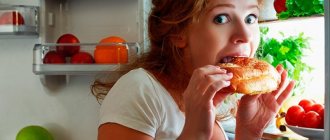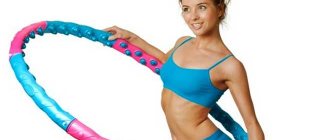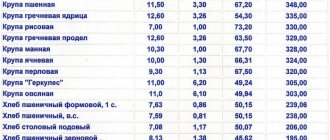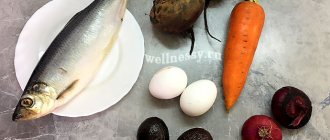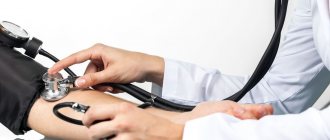Why does belly fat grow?
It’s not just the consumption of unhealthy foods that contributes to the formation of fat cells in the abdominal area.
Sometimes grueling workouts in the gym and a strict diet do not help get rid of fat deposits in the abdominal area.
An increase in waist size is also observed with:
- Insufficient physical activity. It is the “sofa” lifestyle that leads to the formation of a fat layer not only on the stomach, but also on the sides, arms, buttocks and thighs.
- Stress. Overexertion stimulates the production of cortisol in the body, due to which excess sugar begins to be released from the liver. As a result, a person begins to experience a feeling of hunger, which constantly eats.
- Health problems. Belly fat is formed not only due to poor nutrition, but also due to hormonal imbalance, heart and vascular diseases.
According to research by nutritionists, the tendency to gain excess weight can also be “inherited.”
Simple carbohydrates in the diet
The main source of energy in food is carbohydrates . It is almost impossible to remove them from the diet, since they are found in almost all foods, including vegetables and fruits.
But in the fight against fat, you cannot completely exclude the source of energy from your diet. You just need to introduce the “correct” carbohydrates into the menu, which are not deposited on the waist, but, on the contrary, reduce its size.
The main source of energy in food is carbohydrates
There are 2 types of carbohydrates:
- Complex (slow);
- Simple (fast).
The way of eating when fighting excess fat involves excluding fast (simple) carbohydrates from your diet.
They are contained in:
- potatoes:
- bananas;
- sugar;
- dates;
- carbonated drinks;
- pasta;
- grapes;
- flour products;
- baking.
When these foods are consumed, insulin production rises and falls sharply, thereby provoking hunger.
Slow (complex) carbohydrates “work” according to a different principle.
Once in the body, they slowly break down and thereby prevent sugar from rising sharply. As a result, the feeling of hunger appears much later, and a person consumes significantly fewer calories during the day.
Be sure to read: How to eat to get rid of your belly and sides, what foods to exclude, diet at home
The way of eating when fighting excess fat involves excluding fast (simple) carbohydrates from your diet.
Complex carbohydrates include:
- nuts;
- berries;
- legumes;
- vegetables;
- durum pasta;
- whole wheat bread.
To prevent the foods you eat from turning into fat on your stomach, you must adhere to a 1:3 ratio when eating, where one serving is simple carbohydrates and three are complex.
Consumption of animal fats
Frequent consumption of animal fats in food can lead to an increase in the size of the abdomen, as well as provoke problems in the cardiovascular system and increase cholesterol levels.
Dangerous products in this category include:
- salo;
- fatty cheese;
- butter;
- pork.
You can replace dangerous fats with products that contain less fat.
These include:
- poultry meat;
- reduced fat dairy products;
- eggs;
- beef;
- low-fat fish;
- rabbit meat;
- seafood.
When fighting excess weight around the waist, it is important to understand that you should not completely exclude fats from your diet, since they contribute to the proper absorption of vitamins and normalize the production of hormones.
Salty food
In the fight against extra pounds, nutritionists advise giving up salt. Of course, this product does not increase the overall calorie content of dishes, but it promotes fluid retention, which leads to a slowdown in metabolic processes in the body.
Nutritionists advise giving up salt in the fight against extra pounds.
As a result, the belly either does not disappear, or goes away, but very slowly. For people who find it difficult to eliminate salt from their diet, experts advise adding the spice not during the cooking process, but before serving it.
Fried foods
Heat treatment of products in butter or vegetable oil significantly increases the calorie content of the dish, thereby adding kilograms.
To get a waistline you will have to give up fried foods and prepare food in other ways. For example, steamed, using a grill or in the oven.
How food turns into fat: no, carbohydrates and sugar do not go into fat - 6 myths
Have you ever thought about how we get fat?
Well, that is, it’s clear - eat a lot, wider your waist. But how does the body convert food into fat? People are much less interested in this process than in the opposite process - the breakdown of fat, and in vain - because without understanding the other side of the coin, it is difficult to get it.
We decided to talk about this amazing transformation in simple, understandable words and give a couple of important tips that will help you better understand your body and make it easier (yes, we veiled the word “lose weight”).
This article will be especially helpful for those who believe that specific macronutrients (such as fat or carbohydrates), foods, and meals are to blame for their weight gain.
So, let's go.
The first thing that is important and needs to be accepted: any macronutrients in large quantities contribute to fat gain . Yes, even protein, if you eat more of it than you need, i.e. Get more calories in a certain period of time than you can spend on energy needs.
The key to storing fat is not what you eat, but how much. Many continue to stubbornly not believe in this, citing some arguments about the glycemic index or insulin. We would like to once again remind you of the important points (briefly):
- The glycemic index does not affect weight loss, it only affects blood sugar levels. If you eat a product with a high GI, this only means that after eating it, your blood sugar level will rise faster than if you eat equal portions of other carbohydrate foods.
This does not mean that all the calories from it will inevitably go to fat, it only means what is written above. Only those people who have problems with this, such as diabetes, insulin resistance, etc., need to monitor their GI.
- Insulin is not the “fat gain hormone,” as it has been dubbed on the Internet. Insulin resistance is based on a) physical inactivity (little amount of movement in life, which, by the way, more dangerous than smoking), b) stable overeating, c) heredity.
As you can see, both factors depend only on you. We ourselves create a vicious circle for the body: we eat a lot of food, the body releases a lot of insulin. A lot of insulin + low activity = low responsiveness of cells to it. Low cell responsiveness to it = high insulin resistance. High insulin resistance = diabetes and other troubles.
We discussed the whole process in detail in the article about insulin , don’t be lazy to study it.
- Protein is not directly stored in fat, but it makes you fatter. If you eat a lot of protein (it is generally accepted that by “a lot of protein” they mean more than 2 grams of protein for every kg of body), you will spend less fat and carbohydrates.
Here we will quote Lyle MacDonald, known to everyone who loses weight and exercises, he clearly explained these processes:
“The protein will not be converted into fat and stored. But if you eat a lot of protein, the body will use it for energy (rather than carbs and fats). Which means other nutrients will go into reserves.
Which means that overeating protein will make you fat, just not directly, but due to the fact that all the fat you eat goes under the skin.
Of course, protein has the highest thermic effect; more incoming calories will be used to digest food. So too much protein is less likely to make you fat anyway, but if the balance is exceeded, you will get fatter.
But not through direct conversion of protein into fat, but through a decrease in the number of other nutrients burned.
- Sugar doesn't go straight into fat. A lot of people (you can’t even imagine how many people believe this) think that if you eat sugar, you’ll never lose weight, no matter what.
Of course, otherwise it would be very sweet (yes, irony) and simple: well, just don’t eat this and you are guaranteed to lose weight. But is that really what happens? Scientists asked themselves this question and conducted a 6-week study of 2 low-calorie diets.
The first diet consisted of sugars at 43% of total calories. The second is only 4%. There were no significant differences in body weight or subcutaneous fat loss between the two diets .
Everything again comes down to the notorious calories, so let them go!
- Carbohydrates also do not go directly to fat.. And again, Lyle's quote:
An excess of carbohydrates still affects your fat reserves, preventing you from burning the fat you eat during the day. This is why exceeding your daily caloric intake by 500 calories of fat or 500 calories of carbohydrates makes you fat, they just do it for different reasons and in different ways.
An additional 500 calories of fat are simply deposited under the skin, 500 calories of carbohydrates make it so that all the fat eaten during the day will go into reserves, because carbohydrates will be oxidized, not fats.
- However all of the above does not mean that any fat eaten goes into fat. More precisely, not quite so: every day, all dietary fat is deposited in fat cells after eating - it does not remain floating in the blood and is not burned immediately after eating.
But if you are on a diet, then fat is taken from reserves to provide the body with the missing energy. But an excess of dietary fat is directly stored in reserves.
We need to eat fat, we really, really need it for the production of cholesterol , bile, cell membranes, etc.
So, imagine you ate something tasty and healthy. What will happen in your body after this? The teeth thoroughly grind the food, and saliva moistens it - this is necessary for convenient passage through the gastrointestinal tract and further breakdown.
Saliva, by the way, contains enzymes (enzymes) that break down complex food components into simpler ones. Next, the bolus of food is sent to the stomach, which begins to contract in order to grind the food even more and mix it with gastric juice.
Pepsin, an enzyme that breaks down proteins into molecules that consist of two or more amino acids - peptides, and hydrochloric acid help break down food, turning it into a liquid or semi-liquid substance called chyme.
It enters the initial part of the small intestine or the so-called duodenum (the place where the gallbladder secretes bile). In order for fats to be more easily absorbed by the body, bile dissolves them in water.
Enzymes from the pancreas enter the duodenum and then break down sugars, fats and proteins. Now that everything has dissolved and is in liquid form, absorption occurs through the mucous membrane of the small intestine.
After all, all nutrients are distributed throughout the body. What happens to former carbohydrates?
So, the resulting glucose enters the bloodstream, from where it goes either to glycogen (in the liver and muscles), or to the necessary needs of the body.
Fat also goes into the bloodstream, but then goes to the liver. Not all lipids are absorbed by the body; for example, fats from peanuts are not absorbed. The liver uses some fats to synthesize other important substances (such as cholesterol), and sends the rest to fat cells, where they remain until needed.
Proteins break down first into peptides, then into simple amino acids, which are absorbed through the mucous membrane of the small intestine and enter the bloodstream. From here, some stored amino acids are used for the construction of various tissues necessary for the body.
It is quite difficult to achieve an excess of protein in the body (protein reserves in the body are about 10-15 kg, and even if you eat 200-300 grams per day, this is much less than what the body can store) and in any case, there will be no protein processed into fat and stored.
“Excess” protein is not excreted from the body and does not rot in the kidneys, it’s all nonsense. The body simply begins to use protein as energy, and other nutrients (fat and carbon) will go into reserves.
The important point that you need to take away from all this for your successful and wonderful weight loss:
- If you eat more calories, no matter which macronutrients, than you need, you will gain weight.
- If you eat a lot of carbs and little fat, you will burn a lot of carbs and little fat. Better eat less carbohydrates (40-60% of your diet) and you will burn less carbohydrates and more fat.
- A lot of protein does not equal weight loss. If you eat a lot of protein, you burn a lot of protein and little fat and carbohydrates); eat less protein and you'll burn less protein (and therefore more carbs and fat).
- Fat is deposited and consumed every day, regardless of the caloric content of the diet, this is a constant. We only get fat if we store more fat than we burn. We lose weight if the body uses more fat than it has time to store. And this is determined by the overall calorie deficit during the day.
An important point: if you do not eat fats, then carbohydrates turn into fat through de novo lipogenesis. This occurs when calories from fat fall below 10% of your total daily calorie intake. For example, when on a 2500 diet we eat less than 250 calories from fat (less than 27 grams of fat).
In short, you will not deceive weight loss and your body. You need to eat all your macronutrients, distributing them so that you end up with a calorie deficit of 10-20%. Absorbing one of the macronutrients (protein, fat or carbohydrates) will not give you extra points.
If a person eats more than his norm, he gets fat, regardless of cheating with macronutrients. We very, very strongly recommend that you read the book “ Dietary Nonsense ,” which will help you get rid of the false myths that poison your life.
View the book
What is the point of observing all these stupid but strict restrictions, doing what you don’t want, if it doesn’t work and this has been proven a long time ago ?! After all, losing weight is very easy - you just need to listen to yourself, know how the body works, eat right and exercise for your pleasure.
But everything unnatural - carbohydrate-free diets, protein meal replacements, fasting - these are typical dietary nonsense, which usually lead to serious disorders in the body, including anorexia, bulimia, colitis, gastritis, etc. And it’s not at all possible to lose weight help.
- Why will it be harder for you to lose weight in the future if you were a chubby child?
- Insulin and effective weight loss: how is the hormone related to fat gain?
- One is tasty, the other is healthy: 2000 kcal diets with BJU
[Total votes: 32 Average: 4.4/5]
Bone Wide
This article was reviewed by a certified nutritionist who has a bachelor's degree in nutrition and dietetics, D. G. Veremeev.
Articles are for informational and educational purposes only and are not a substitute for professional medical advice, diagnosis, or treatment. Always consult your physician with any questions you may have about a medical condition.
What foods to avoid to lose belly fat?
A proper menu that promotes weight loss should not include certain types of foods.
Sweets
Confectionery products are pure carbohydrates.
To get rid of the hated “apron,” a woman will have to give up:
- cakes;
- chocolate;
- cakes;
- sweets
Be sure to read: Which foods burn belly and flank fat better than others?
For those with a sweet tooth who cannot imagine their life without sweets, their favorite delicacy should be replaced with dried fruits, honey, natural marmalade and marshmallows. But even these products should be consumed within reasonable limits.
Flour products
It will be possible to get rid of fat in the waist area only after flour products disappear from the daily diet.
It will be possible to get rid of fat in the waist area only after the following disappear from the daily diet:
- semolina;
- pasta (except for durum products);
- White rice;
- baking;
- bread.
These products can be replaced with their lower calorie “brethren”:
- brown rice;
- oatmeal;
- rye or bran bread;
- pearl barley;
- pasta based on buckwheat or durum wheat.
Important! Products with a high flour content attract fat like a magnet and increase body weight in a matter of days.
Pork
The human body will not function normally without meat. But pork contains too much saturated fat, which doesn't help you lose weight.
To make the reflection in the mirror pleasing, instead of pork cutlets, it is better to eat baked poultry, rabbit or beef.
Potato
They prefer to eat this favorite vegetable in Russia fried, along with a good portion of lard. But 1 serving of this dish contains at least 300 kcal.
And that's not counting the lard. Women who want to get a slim body can only eat potatoes boiled or baked. Pre-peeled vegetables must be soaked in cold water for 2-3 hours.
Pasta
Properly prepared pasta will not harm your figure. Excess fat will appear only if you season the side dish with a fatty butter-based sauce or add smoked meats to the main dish.
In the fight against excess weight, you can eat pasta only with stewed vegetables, low-fat fish or mushrooms.
Sweet drinks
Properly prepared pasta will not harm your figure.
The main enemy of the waist is sugar . In view of this, it is recommended not to add granulated sugar to coffee, tea or compote. Juices can only be drunk freshly squeezed. With regular use of the packaged product, belly fat will appear within a week of use.
In the fight against excess weight, it is advisable to drink unsweetened drinks throughout the day. If bitter coffee or tea does not bring pleasure at all, you can sweeten it with honey or stevia.
Be sure to read: How to remove belly and sides: super simple exercises + ready-made workout program for home
Alcohol
Intoxicating drinks themselves are non-caloric (not counting beer). But the foods that a person consumes while taking them definitely add extra pounds.
In addition, alcohol overloads the liver, slows down metabolism and retains water. To burn fat, you should remove alcoholic drinks from the menu.
Carbonated drinks
It will be possible to protect your health and figure only by completely abstaining from carbonated water
. By drinking 200 g of Coca-Cola, a person consumes 1/7 of the daily requirement of carbohydrates and does not quench the feeling of thirst. In addition, such drinks increase blood sugar, gradually leading a person to diabetes.
You can protect your health and figure only by completely abstaining from carbonated water.
Fast food
Fast food dishes not only contain a lot of preservatives, but are also eaten with fatty sauces. The body does not receive saturation from such food; accordingly, the person overeats and exceeds the permissible caloric intake. As a result, the numbers on the scale increase daily.
- Sugar -
It’s tempting to put an equal sign between the words “sugar” and “carbohydrates,” and there is a justification for this - the product consists of 100% of them. Once in the body, sucrose is instantly absorbed, breaking down into fructose and glucose, nourishing our body and giving us strength and vigor, which on the one hand is good and makes sugar a must-have product. On the other hand, each product has its own consumption rate, and for sugar it is 60 grams per day for a man and 50 for a woman. Our body is supplied with sugar not only in the form of white grains, but also through other foods. Excess is inevitable, and it is rapidly deposited under the skin in the form of fat.
Eating Habits That Can Lose Belly Fat
You don't need to go on a diet to reduce your belly fat. It is enough to develop eating habits that will help you cope with the problem without strict dietary restrictions.
A woman who is losing weight needs:
- have a full breakfast;
- in 30 min. drink a glass of water before meals;
- eat more vegetables and fruits;
- chew food thoroughly and slowly;
- drink coffee no more than once a day;
- replace black tea with green tea.
There is no need to suddenly change your lifestyle. New habits should be introduced slowly, allowing less than 5–7 days for a new rule.
Eat right
1) Diversify your food. If you want to lose weight, on the one hand, you must reduce calories, but on the other, provide yourself with all the necessary vitamins and microelements. Only then will your body be able to fully function and remove toxins and waste, the excess of which inevitably leads to extra pounds. Make sure your diet includes lactic acid products, meat, poultry, fish, seafood, legumes, grains, vegetables and fruits. 2) Don't mix. Despite the fact that your diet should be as varied as possible, try not to mix more than 2-4 types of foods at one meal. Also, do not use multi-component foods - muesli, 7-grain bread, assorted seafood, meat or nuts. It will be difficult for the body to cope with such abundance in one sitting. 3) Don't starve. Reducing calories should also follow the rules. If you suddenly reduce the nutritional value of what you eat, your body will go into panic. His reaction will be quite predictable - he will begin to stock up for future use: he will slow down his metabolism and begin to save as many calories as possible, instead of using them to produce energy. As a result, you will achieve the opposite effect: you won’t lose a single gram, and maybe you’ll even gain extra. Therefore, eat at least three, and preferably 5 times a day, but in small portions. If you want to stay at your weight, the calorie content of each meal should not be less than or more than 1500 Kcal; those who want to lose weight should stick to 1100 Kcal.
- Semolina -
Nutritionists are alien to everything that we love and sacredly believe in, including nourishing and tasty semolina porridge. In kindergarten, they hid from us that semolina is a by-product of wheat processing. Essentially a mash of carbohydrates, semolina, generously supplemented with milk, sugar and butter, becomes an extremely nutritious and high-calorie product. Then everything happens according to the well-established “carbohydrates-insulin-glucose-excess weight” scheme, but try to include semolina porridge in the children’s diet on a regular basis, and rickets will also be added to the risk of an obese child.


